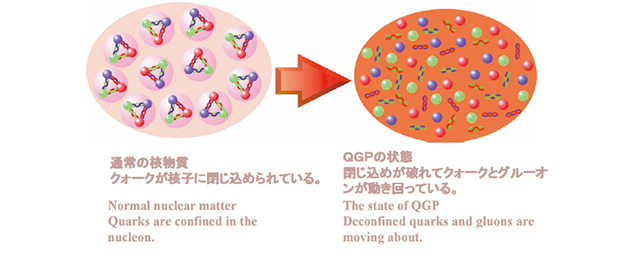 RIKEN BNL Research Center
RIKEN BNL Research Center

Physics of QGP
In the world in which we live, the quarks and gluons that form hadrons such as nucleons and pions are quite strongly bound together so that we are not able to break them apart. This is called color confinement. When the density of matter is increased a great deal so that nucleons are piled up, or the temperature is raised, it is predicted that a new state will appear in which quarks and gluons do not stay within the one hadron to which they are bound. By analogy to the usual plasma that is made when electrons are separated from the normal atom, we call it quark gluon plasma (QGP). This state is thought to have existed immediately after the Big Bang, a long time ago when the temperature was very high.

Researchers at the RIKEN BNL Research Center (RBRC) are trying to elucidate the nature of the new state of matter, QGP. During 2000, at Brookhaven National Laboratory (BNL), a new experiment at the Relativistic Heavy Ion Collider (RHIC) began to create QGP under the world's watchful eyes. We at RBRC are the part of this experimental project at RHIC so that we will be able to elucidate the QGP state theoretically and experimentally. Recently, it was theoretically predicted that in the deconfined phase at low temperature and extremely high density, there will exist a qualitatively new phase called ”Color Superconductivity." Similar to the usual superconductivity in metals, quarks in this phase form "Cooper pairs" that have color and show super-conductivity. RBRC's researchers have been giving important contributions to the investigation of this new state.
Recently, some experimental data suggested that the initial state in highly energetic heavy ion collisions may be well described by another new state of matter, color glass condensate (CGC). As the energy becomes extremely high, nucleons and even nuclei can be universally viewed as a state in which gluons moving slowly and coherently are saturated at high density, in contrast to the conventional low energy picture of nucleons in terms of the constituent quarks. This is what CGC is like. RBRCs researchers are theoretically trying to make sure of the CGC description of the initial state in the heavy ion collisions.
RBRC Research Areas
-

Quantum Chromodynamics
Research into phenomena caused by the Strong Force
-

Spin Physics
Experimental attempts to measure quark and gluon spin and their distribution with the nucleon
-

Lattice QCD
A theoretical method to investigate the dynamics of QCD
-

Physics of QGP
Elucidating the nature of a form of matter called quark gluon plasma
